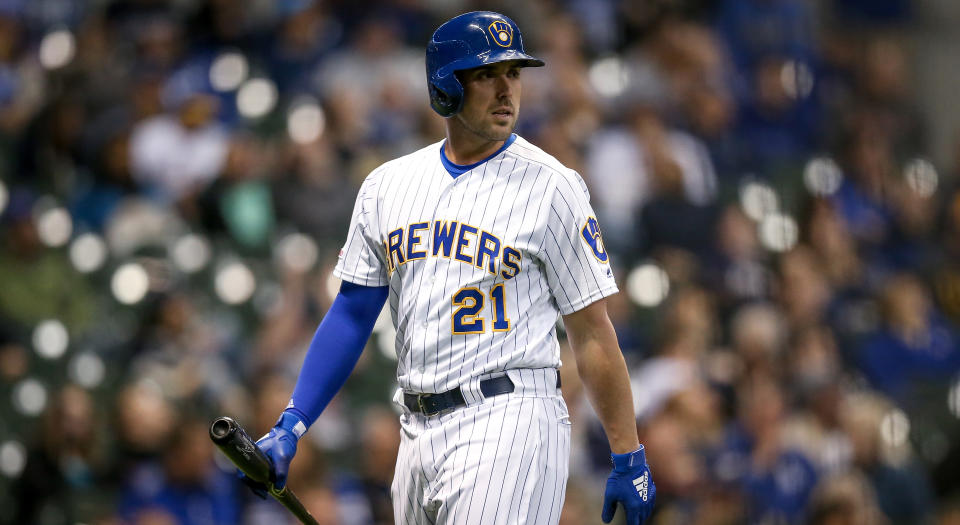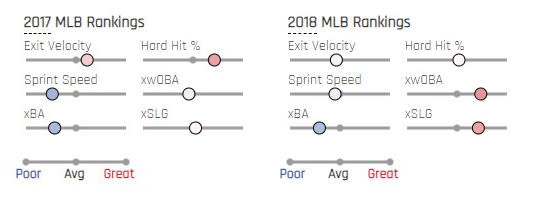Blue Jays make bounce-back bet with Travis Shaw signing

The Toronto Blue Jays made another addition to their roster on Sunday, reportedly agreeing to a one-year deal with corner infielder Travis Shaw. The deal, worth $4 million (with an extra $675K of possible incentives) for one year, provides very little risk for a team with as much hallowed financial flexibility as the Jays are currently carrying. Shaw was non-tendered by the Milwaukee Brewers at the beginning of the month and the fit in Toronto makes pretty good sense on paper.
What the Blue Jays see in him is fairly straightforward and he provides a couple of useful tools that the team was lacking heading into the offseason. Yet, it’s not a lock that Shaw will be able to put into practice the same skills that he flashes on paper, as his recent history has shown anything but stability.
Here’s a look at the up and downsides of the newest piece of the Blue Jays lineup.
The Good

It certainly doesn’t take a lot of squinting to see where Shaw’s biggest contribution to the team will hopefully come from. He provided power with aplomb in his first two seasons with the Milwaukee Brewers in 2017 and 2018, combining marks of 31 and 32 home runs in those campaigns with doubles by the handful. He posted 34 two-baggers in both 2016 and 2017. Those marks kept him in the top-20 in the National League in slugging and OPS in ‘17 and ‘18, giving him the traditional profile of a prototype corner infielder. You don’t earn a nickname like “The Mayor Of Ding Dong City” without hitting a lot of ding dongs, after all.
His skills at the plate also include above average plate discipline. He drew 78 walks in 2018 and his 13.3% walk rate was 17th in MLB that year, a mark he matched again in 2019 albeit in a much smaller sample of plate appearances.
Combined over his two breakout seasons with the Brewers, he held a .258/.347/.497 line — good for a 120 OPS+, 120 wRC+, and 7.1 WAR per FanGraphs.
Shaw is also not just a bat. In fact, he rated out as a well above average third baseman throughout his career. As a third baseman, he’s been worth 26 defensive runs saved in his career, grading out with positive range and a 4.3 UZR at the position over 434 appearances at the hot corner. He’s also played 129 games at first base — also to positive results — with a 10.4 UZR/150. He figures to play the majority of the time at first in Toronto, and may be a useful defensive or rest sub at third when Vladimir Guerrero Jr. needs a day off.
Add in that Shaw did it all as a left-handed hitter and the profile is easy to see. Power, patience, and defensive versatility that would fit handily in the middle of absolutely any lineup in baseball. The Blue Jays could certainly use a lot of the things he does when everything is going well and if this is the version of the player they’re getting, $4 million is going to seem like a bargain.
The Bad
You may have read the above section and thought “What a steal! Why was he available at that price, or at all?”
Well, Shaw was absolutely awful in 2019.
He posted a paltry .175/.281/.270 line with 89 strikeouts across 86 games, a performance so dreadful that he was sent to Triple-A twice for extended stints throughout the year. He dominated Triple-A pitching — you’d certainly hope so — in his 42 games at the level, but his problems at the plate kept him from ever finding his footing in the major leagues during the season.
The biggest issue on Shaw’s plate in 2019 was an astronomical 33.3% strikeout rate, fuelled by a dramatic dip in his ability to make contact. After posting identical 87.9% contact on in-zone swings in 2017 and 2018, the number plummeted more than ten percent to 76.7% in 2019.
It’s possible that part of the contact and strikeout issue stemmed from Shaw’s attempt to get more lift on his swings, as his average launch angle also jumped by a considerable margin. After years of 14.6 and 16.6 degrees in his breakout years, his 2019 launch angle was 24.4. This resulted in a two percent increase in the number of pop ups he hit, as the search for extra fly balls mostly fizzled out to the infield.
If there’s a silver lining to be found, outside of the strikeouts there were plenty of things you could look at to like about his approach last year. He hit a higher rate of line drives than in any previous season, hit fewer grounders, swung at fewer pitches outside the zone, and stayed more or less in line with his normal rate of hard hit balls. If you take away the ten percent drop in his ability to make contact, he was as disciplined at the plate in 2019 than he ever has been. There just weren’t the same results when he swung.
Those silver linings aside, strikeouts are ultimately a completely unproductive use of an at-bat, and the extended slump left him with a -0.9 WAR and just a 47 wRC+ on the year. For players with at least 250 at-bats on the season, Shaw posted the 14th-worst WAR and 2nd-worst wRC+ in all of baseball.
There were worse every day players in the league than him last year, but not many.
The Verdict
Ultimately, the Blue Jays are paying a fairly cheap price on what could turn out to be an every day middle of the lineup player. It might be naive to expect him to immediately bounce back to a 30 home run status, but his discipline and defensive versatility alone should grant him enough runway to see if he can figure it out for the team.
Rowdy Tellez showed last season that he has big league power but not on-base ability, while Brandon Drury held on with positional versatility and a worthy glove to spell Guerrero Jr. at the corner when needed. In an ideal world, Shaw combines the best values of both of these players, while providing a blueprint for some of the team’s high-power high-strikeout low-walk profile players for how to be a little more selective at the plate without sacrificing too much power.
Additionally, with four years and 53 days of MLB service time under his belt, the Blue Jays get another year of control through arbitration with Shaw if he does enough to impress and make the argument to be kept around for another year. With team payroll where it is at this point, his salary won’t hamper their pursuit of more pitching, or even another first base bat if they deem Tellez an unnecessary option.
If not? The Jays can put him back where they found him, as a non-tender player available to the highest bidder on the free agent market.
The signing fits exactly into the type of player the Blue Jays should be filling in around their core of young stars at this point, where a bounce-back breakout can raise them higher than expected, but a bust won’t leave their books in ruin for the future.
More Blue Jays coverage from Yahoo Sports

 Yahoo Sports
Yahoo Sports 
